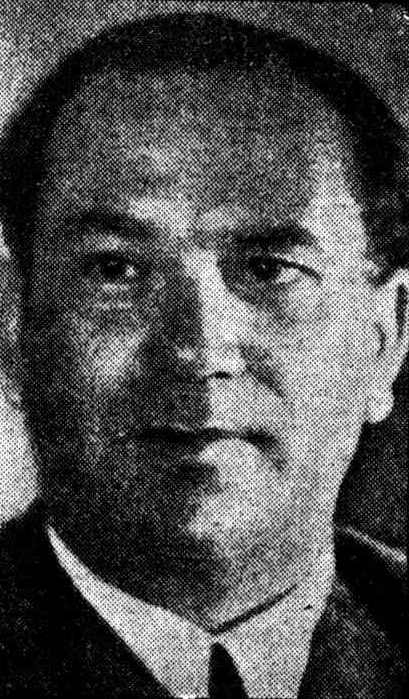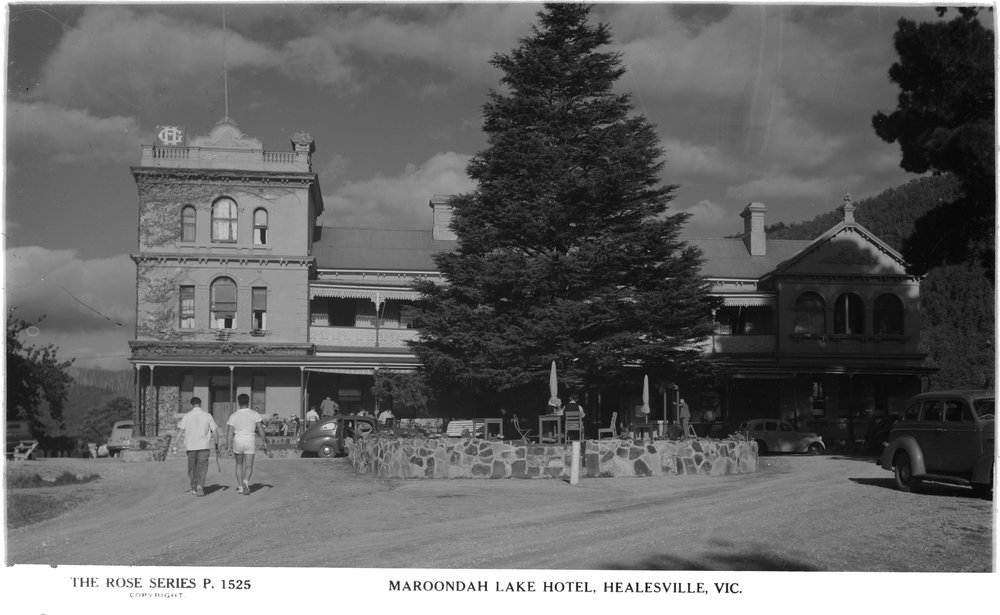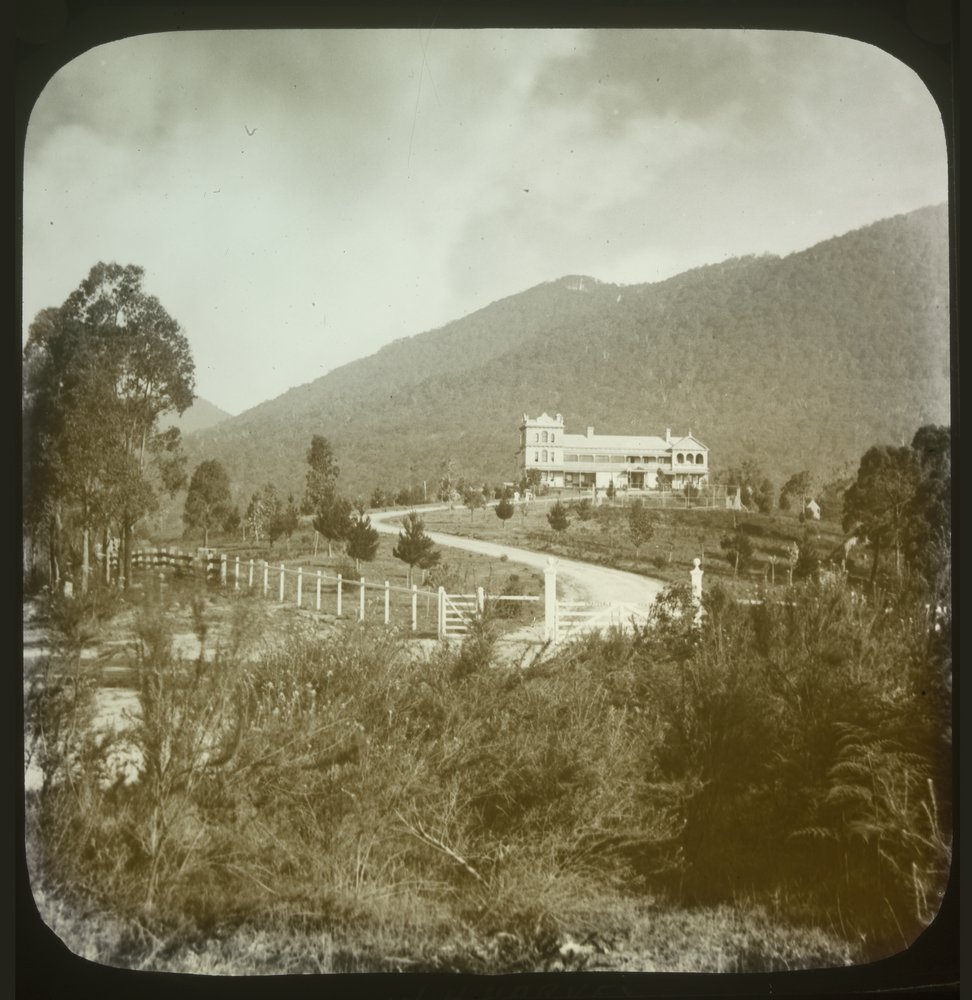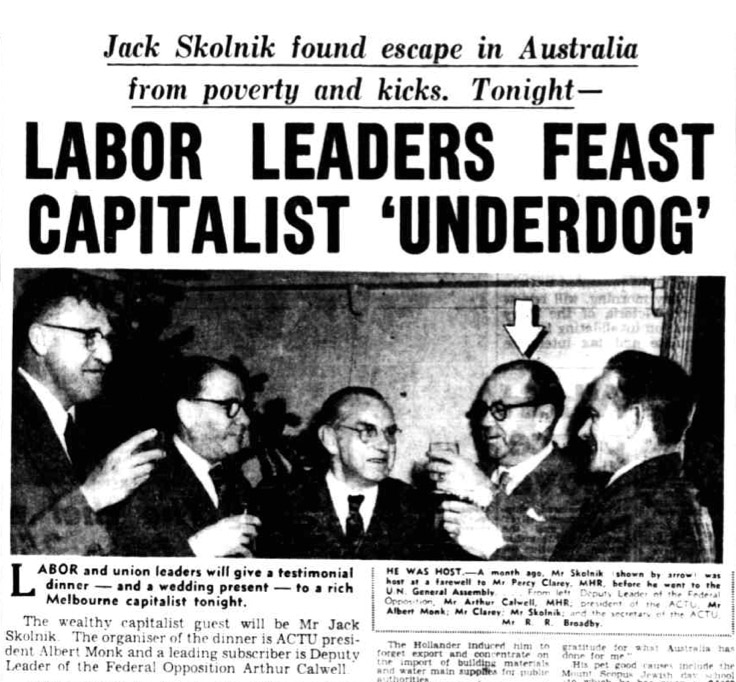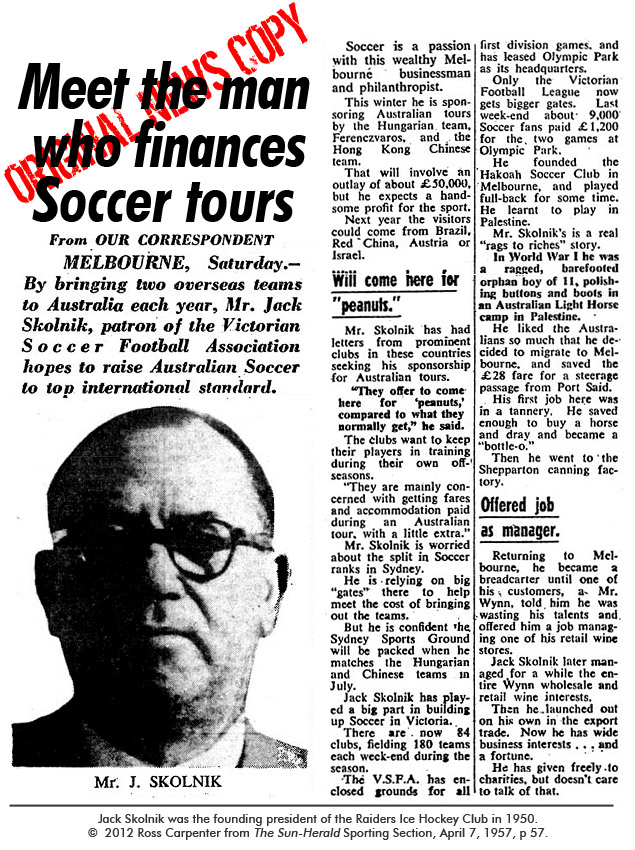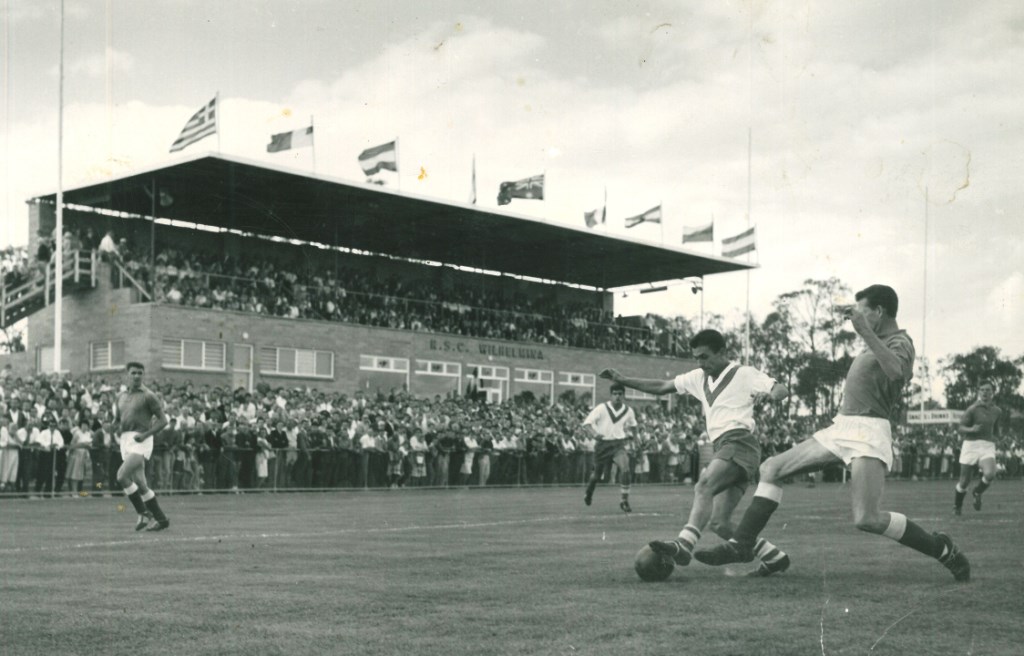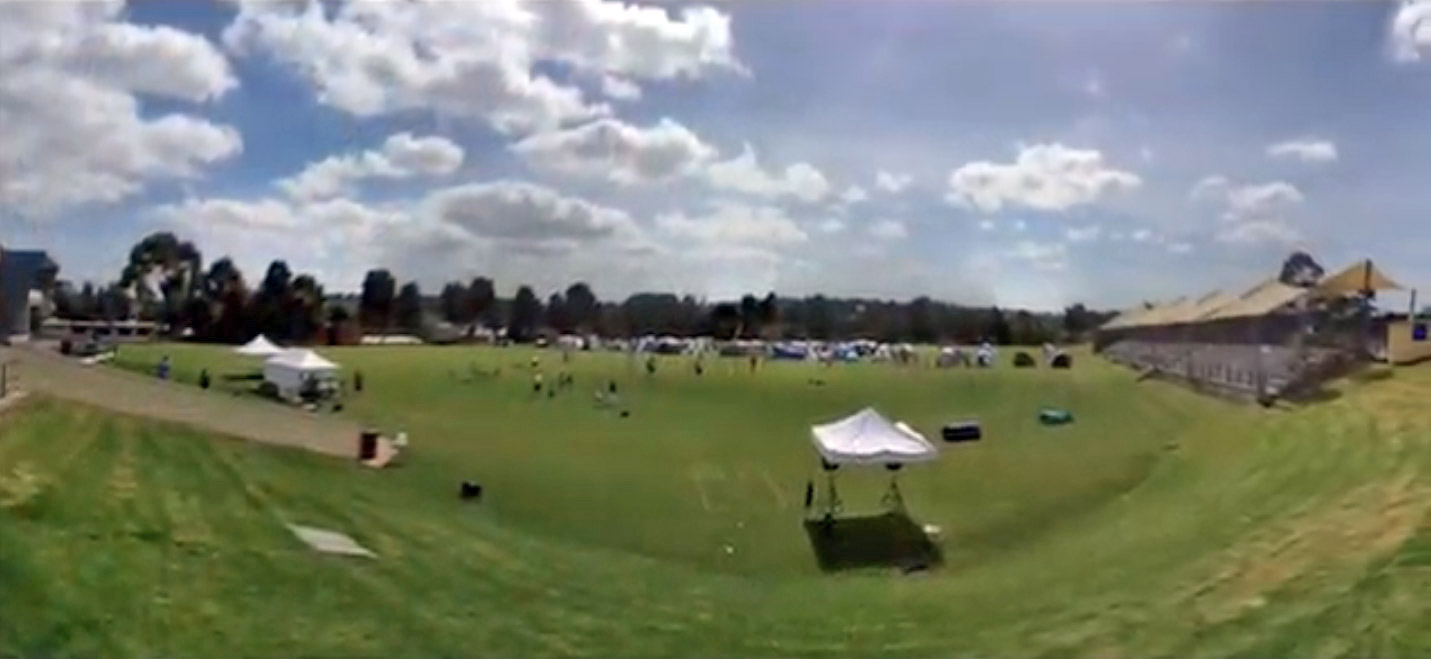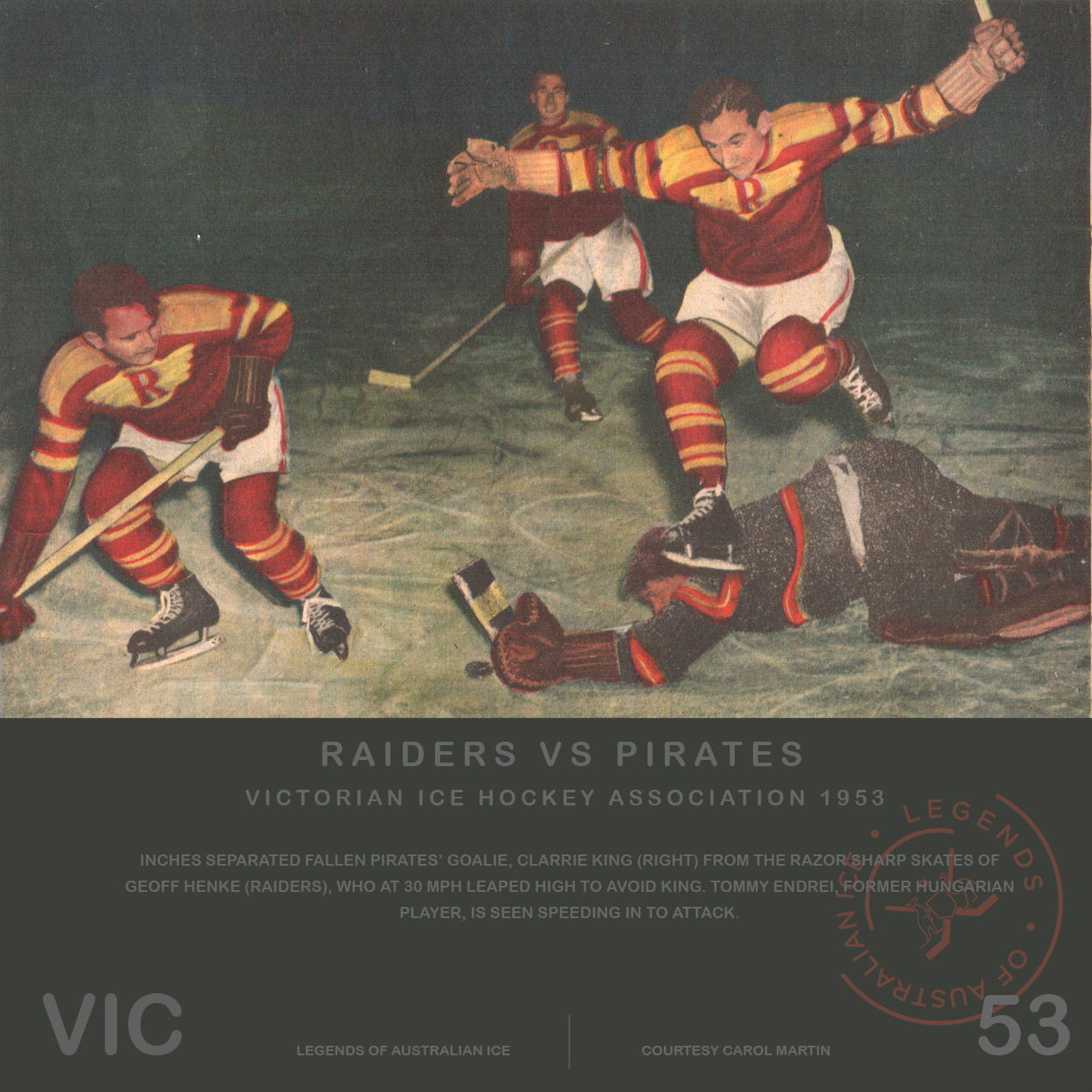
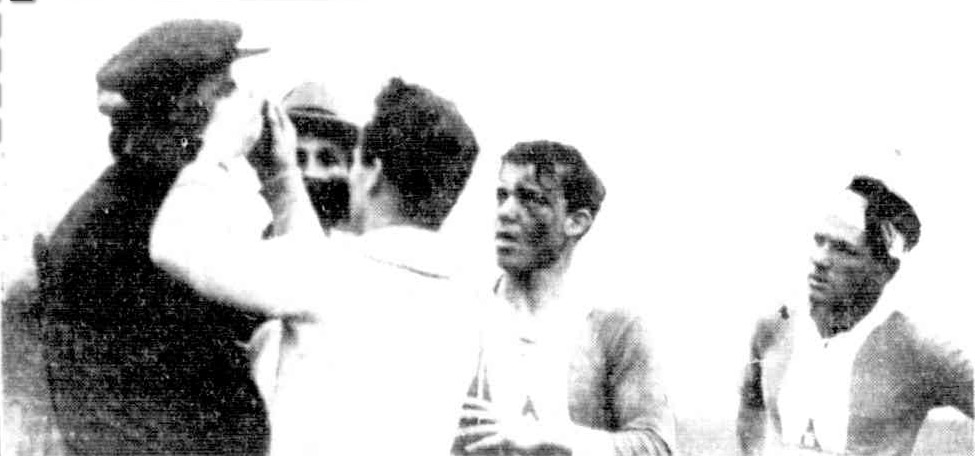
With Hakoah football club.
On right. Caption: Casualties were numerous among the Hakoah players in the soccer match against Essendon. T Silver, the goalie, received a nasty crack. J Fraser (referee) gives first aid while Cohen and J Skolnik watch operations. Sporting Globe, Melbourne, 8 Aug 1928, p 12.

Farewell dinner.
The scene at the farewell dinner last night to Ml Clarey MLC who is going to the United States to represent Australia at thge International Labour Organisation Conference. From left: Senator J M Sheehan, Judge Stretton, Mr J Skolnik, Mr P Clarey, Mr A Monk, secretary of the ACTU, Judge Foster, Mr Cain MLA and Mr Crofts. The Herald, Melbourne, 25 April 1944, p 5.
Raider Nation
Jack Skolnik and the Import Business
![]() There [in the First Australian Light Horse Camp in Palestine], for the first time in my life I was in a community where everybody was kind to me, where everybody spoke pleasantly, and where everybody treated me as a human being...When business people ask me what the so-and-so a rich man is doing 'messing about' with the ALP, I tell them that even though luck has come my way I still have in my bones the feeling of an underdog.
There [in the First Australian Light Horse Camp in Palestine], for the first time in my life I was in a community where everybody was kind to me, where everybody spoke pleasantly, and where everybody treated me as a human being...When business people ask me what the so-and-so a rich man is doing 'messing about' with the ALP, I tell them that even though luck has come my way I still have in my bones the feeling of an underdog.
— Jack Skolnik, Melbourne, 1954. [1]
No slaving money-grabber, he likes to work at home in pyjamas until midday, playing some of his 480 microgroove discs, toying with the day's half-dozen whiskey-sodas, making Australia-wide calls, and planning the afternoon's deals. And he likes a long, leisurely and good lunch.
— Journalist Robert Gilmore on Skolnik, in The Argus newspaper, Melbourne, 1954. [1]
THE ITALIANATE MANSION on Melbourne's most famous boulevard is long gone, but not the Jewish day school serving the influx of Holocaust refugees there in 1949. It just moved on to a larger campus in Burwood next to Deakin University. The college took its name from Mount Scopus in Jerusalem which remained under Israeli control after the 1948 Arab-Israeli War. The patch of green at the back of the school, known so well by so many as a meeting place, is really the holy grail of College sport. It took its name from its benefactor, Jack Skolnik, a passionate sports fan, supporter and patron. The high-profile Melbourne businessman and Zionist, had just died leaving a philanthropic legacy that included the £5,000 Skolnik Oval and several sporting clubs. The founder of the Jewish sports club Hakoah in Australia was a one time full-back of Melbourne's Hakoah soccer team.
 Jack Skolnik in later years. Unknown artist. Valerie O'Neill's portrait of his wife Rita was a Finalist for the 1962 Archibald Prize.
Jack Skolnik in later years. Unknown artist. Valerie O'Neill's portrait of his wife Rita was a Finalist for the 1962 Archibald Prize.
His Raiders ice hockey club were the last VIHL champions, then four-time VIHA champions. Five straight seasons—a record, if you care to count the breakaway League. Skolnik's life arced through the interplay of Australian-Middle Eastern things in an intricate way. So intricate, it defied the task of recorded history.
Further east, the soccer club founded by Skolnik's business partner, John van Hoboken, opened a new facility at Jubilee Park Ringwood. They beat out the "Greek" team, South Melbourne Hellas, 2-1, with bands, marching girls and speeches in front of 5,000 supporters.
Dutch migrants seemed to like the booming urban growth corridor of the outer east, and the Ringwood Soccer Club Wilhelmina liked them. The one hundred thousand immigrants who arrived from the Netherlands in the late 1940s and '50s were a sizable proportion of the 1.25 million Europeans who poured into Australia during those years. [8]
By the late 1950s, Italian, German, Austrian, Hungarian, Yugoslavian, Czech, Polish, Maltese, Greek, Jewish and Dutch teams had formed across the country, most adorned in national colours, symbols and emblems of the "homeland". In Victoria, van Hoboken's club, Wilhelmina DSC, was the heart of Dutch soccer. [8]
These "New Australian" clubs revitalised and transformed local football with new skills and new ways of looking at the game. They attracted new players, officials, backers and spectators to a sport that at times had struggled to emerge from the shadows of Australia's other three football codes. Even a "World Cup" tournament sprouted into a fixture of the football landscape in Melbourne throughout the 1950s and early '60s. [8, 9]
Skolnik brought out soccer teams, guaranteeing the tours with sums as high as £15,000 per team. "They offer to come here for peanuts compared to what they normally get," he said in 1957, the year he sponsored Australian tours by the Hungarian team, Ferenczvaros, and the Hong Kong Chinese team, with an outlay of £50,000. [10] He financed the tour of Australia by Rapid Vienna managed by Max Gold who had played with Kurt Defris, Hakoah's football and ice hockey secretary.
Plagued by a shortage of venues with spectator seating, Skolnik helped Hakoah lease St Kevin's Oval at Heyington, while planning to build a grandstand and Press Box at his own expense. Although competitive in league soccer, Hakoah's best result in the post-war years was Runner-up on goal difference to the all-conquering Juventus in 1956. But the club's Cup form was outstanding, winning the Dockerty Cup four times straight (1953-6), reaching the Final from 1959-62, and winning in '66 and '73.
The first commercialization of ice hockey in Australia began in Sydney in 1938 with Jim Bendrodt's Ice Palais Bears. But it was interrupted by wars—the world war, and the war against shamateurs inside the local associations. At the St Kilda Cricket Ground in 1939, Skolnik donated the Skolnik Cup for interstate Under-20 soccer between Victoria and South Australia, [2] as the curtain-raiser to the Australia v Palestine game. A guarantor of the visitor's tour, he helped four of the team apply to stay in the country through the Hakoah club, and offered Beth-Halevy employment [4].
Much of Skolnik's effort was directed at coaching Australian teams on European methods, and advancing the Australian game to the Olympics. [8] A patron of the Victorian Soccer Football Association, he played a big part in building soccer into a popular spectator sport in Victoria. By 1957, there were 84 clubs fielding 180 teams every weekend of the season. The association had enclosed games for its first division fixture, and leased Olympic Park as its headquarters. Only the Victorian Football League had bigger gates. [10]
In 1950, a few years after war's end, Skolnik founded and presided over the Raiders in the breakaway Victorian Ice Hockey League. Kurt Defris joined him as club secretary, mirroring the Hakoah football club administration. Skolnik learned football in Palestine, [10] Defris in Vienna. After Skolnik's death, Kurt Defris continued as secretary of the Hakoah Football club, right through to when it was known as South Melbourne.
Van Hoboken's Dutch soccer club Wilhelmina had actively recruited top flight players from the Netherlands, and it was not alone. The "New Australian" clubs circumvented paying transfer fee payments to European clubs by having players move to Australia as migrants, and not professional footballers. The practice contributed to the banning of Australia from FIFA for four years. [8]
The recruitment drives of Skolnik's Hakoah soccer club and the Raiders ice hockey club sometimes seemed the same. But if the national ice hockey association led by Ken Kennedy knew, it did not seem to mind. Nor did the International Ice Hockey Federation, even though the nation down under was preparing to compete internationally for the first time since its humble beginnings in Melbourne forty years earlier.
The Hakoah ice hockey club of the early 1960s was not your average outfit by today's standards, due in large part to one of the most distinctive administrations in the Australian game. Spread across two clubs, in two different sports, Kurt Defris was a prime mover, but Jack Skolnik was unlike anything the sport had seen.
Many of the professional football players who arrived in Australia during these years were also skilled at ice hockey, and Skolnik enticed others from countries where ice hockey and soccer were more than amateur sports. The story of ice hockey in Victoria during those years was heavily influenced by the shared interest of both these men in both these offside games, and it quickly spread interstate.
BORN YITZCHAK SKOLNIK [11] in Russia about 1904, the son of Hanna Kolkier and Naaman Skolnik, [4] he was a child refugee from the second wave of "the notorious and bloody programs of Kishinev" at the turn of last century. [1] He lived in Bessarabia where the anti-Jewish riots took place in October 1905.
During the Great War, AIF Diggers brought new hope to the life of the ragged, barefoot orphan boy polishing buttons and boots in the 1st Australian Light Horse camp at Ruhon in Palestine. "I aspired as soon as the war was over to become a member of the nation which produced these soldiers. When at the end I watched General Allenby dismount from his horse to walk through the Jerusalem Gate, I took an Australian's pride in that event". [1]
Skolnik saved the 28-pound needed for a steerage fare from Port Said in Egypt to Melbourne, arriving in 1924, and first working at a tannery and living in rooms in Carlton and Fitzroy. [1, 6] He bought a horse and dray with his first Melbourne savings and worked as a "bottle-oh" all around St Kilda. He worked for SPC in their cannery in Shepparton, joined the Storeman and Packers Union, and later the Albert Park branch of the Labour Party. Back in Melbourne he worked as a baker's delivery man.
Samuel Wynn, [3] a Russian born Australian Jewish community leader, offered Skolnik his retail wine store to manage in Bourke Street Melbourne which he had set up in 1918. Within two years, Skolnik managed all Wynn's enterprise, wholesale and retail, while the family holidayed abroad. He naturalised in 1931, [6] and in 1933, he talked Douglas Jardine and Herbert Sutcliffe into letting the visiting cricket team play Hakoah at soccer during the controversial "bodyline" Ashes tour. [1]
Made a partner in one of the Wynn shops, he left in the early 1940s intending to launch his own export business trading mainly with Israel. But shipping difficulties and a lack of experience nearly sent him broke. His future business partner, van Hoboken, induced him to forget exports and concentrate on importing building materials and water main supplies for public authorities. It was a defining moment and soon the Dutch-English dredging combine they formed had seven-figure contracts in Melbourne and Geelong. [1, 4] The change of heart, which led to the founding of the Australia-Middle East Trading Co, also effected their sporting interests.
In 1950, the year Skolnik founded the Raiders, Victorian ice hockey fans looked set for the season of their lives. The sport that had steadily improved since the war was now booming [16] thanks to the increase in overseas players, the new Victorian Ice Hockey League that had begun two seasons earlier, and the new promotional outlook of the rink managers. [16] By late 1949, the decisive victories of the Victorian association team in the Goodall Cup had taken ice hockey supremacy away from New South Wales for the first time in twenty-five years, and the state's VIHL representative team repeated the dose. [18]
A highly competitive spirit prevailed between the VIHL and the Victorian association, and administration was keen. The development and encouragement of many new players by experienced coaches, and good attendances despite a strike and minor epidemics, led to a feeling of progress.
Victoria had two associations and nine teams, while their rivals' up north had four teams and a game that had somehow fallen into the doldrums. Hardly a new player had arrived in the state team since the war, and players wore three different versions of the state uniform which they saved from earlier years. The goalkeeper played in a sweater borrowed from the St Moritz ice rink. [18]
In Melbourne, the manager-coach of the VIHL Blackhawks, Stan Gray, was playing his part promoting the game. His column in the local Sporting Globe provided insight and perhaps a degree more accountability to many frustrations of the time. Local player movements and personality clashes between the League and association, some of which led to resignations, kept the pre-season in the news. [14]
Under former Hungarian star, Sandor Miklos, the Blackhawks played almost copybook hockey reminiscent of the days before "Frosty" Winter moved to Sydney. Winter coached the 'Hawks to a championship by European methods. So did Miklos, with a line-up little different to the one that had struggled to win a game before he took over.
The legal eagle, who claimed to have lost his wealth when he fled his homeland, was an intelligent player and a good tactician with highly-developed skills. Described as an excellent skater, stickhandler and shot for goal—the complete Canadian-style player—Miklos is widely regarded as one of the best Hungarian players of all time. So much so, Hungary named its Most Skillful Player of the Year Award in his honour in 1990.
The Wildcats benefited from ex-Canadian Al Sengotta, and the Scot Jimmy Elder who assisted the coaching of fellow countryman Steve Patterson and Ted Molony. Some described Elders' success with a few of the younger players as "amazing", proof of "what a lot of hockey talent must be lying idle for the sake of sufficient good coaches to develop it". [16]
The Victorian Ice Hockey League capitalised on the value of many other migrants, players such as Hungarian Tommy Endrei who first suited up for the Pirates before joining the inaugural line up of Skolnik's Raiders. Czech Jan Kurzweil, who first led the Raiders, coached teams in Switzerland and France, represented Czechoslovakia in international games, and probably toured Europe in a "Free Czech Team". [16]
Three former countrymen joined him in the Raiders: Miro Roznetinsky, George Cermak and Joe Lockman. Carol Martin joined in defense at 26, an ex-Wembley Lions junior first recruited by Gray for the VIHL's short-lived White Knights. Winter Olympic administrator, Geoff Henke, was among the locals, and rising up through the club's juniors was Kevin Harris, who some say should have made the cut for the 1960 Olympics. In any event, he represented Australia in the 1964 Olympic playoffs in Tokyo.
When the Raiders won the Gange Trophy in their inaugural season, their League followed the modern trend of the five-man game with two lines. [14] But it folded that season, having given up all hope of gaining Olympic recognition. Its organizers planned to form a National League by pooling resources with similar bodies in Tasmania and Sydney "with the idea of importing overseas stars to make the sport something to queue up for". The Argus newspaper warned "other night promoters better pull up their socks". [32]
The VIHL were based at the Glaciarium, the Association teams at St Moritz. The New South Wales association pressured its Victorian counterpart, led by former NSW player Sid Hiort, to merge the two rinks "so that a truly representative team may be available for interstate games". The League sought affiliation while retaining its own identity, but the association voted to accept the return of the VIHL teams in the "normal constitutional manner". [34]
The VIHL clubs moved back to the association. The Raiders' first manager, Tony Gudgeon, a power in the days of the VIHL, dropped out of the game due to pressure of business "and perhaps a certain amount of frustration". [12]
Energized by the population influx, local organisers pitted overseas players against locals in annual tournaments. Billed Internationals v Australians, the tournaments added depth to the state calendar, but they also experienced problems. Over five weeks in the lead-up to the 1951 ice hockey finals, five top players from leading teams were subject to crude but vicious attacks resulting from illegal checking.
Skolnik notified the association his players would not be available for the series to avoid further casualties. Well out of their depth in the higher skilled game, officials just did not limit illegal checking, and so the top clubs lobbied the association to instruct its referees. [15] Comparatively few Europeans took to the kind of checking that resulted in serious injury, either here or overseas.
Despite the success of the Raiders, Skolnik was best known in the sporting world as president of the Hakoah soccer team. With influence spanning two sports he was strategically well-placed to offer overseas transfer incentives. Examples include Jan Kurzweil who doubled his act as star forward with the Raiders by filling the same role with the Hakoah football club. [12]
Year after year, Skolnik's "Victory Balls" became a stage for presentation of elaborate trophies, such as the canteen of cutlery awarded to Tommy Endrei, and the silver coffee service for captain Kurzweil. Wealthy and enthusiastic patrons also backed the Monarchs club of the time, but with no equalisation strategy, no competitive balance, the gap between rich and poor continued to widen.
This sudden splash of cash in the sport prompted Stan Gray to write "the backing these two clubs and one or two others can command makes one realise what could be done with commercial hockey". [12]
Yet, according to Gray, the next season was "the worst for ice hockey since the war" with many clashes between factions in the association executive. By the time the Raiders fourth straight premiership came around at the end of 1953, the wizards of wealth claimed to be a victim of the combined vote of the weaker clubs.
In October that year, the Sydney Champions, the Bombers, planned to meet the Raiders in what might have been the first national championship playoff. Modeled on the Raiders, Dick Groenteman's club also began as mostly migrants with a wealthy businessman backer in Viv Chalwin. Officials in both cities who decided such trips "undesirable" did an about face when Raiders' captain Tommy Endrei won the backing of the rink managers. They said they would stage the game with or without official support and the Victorian association fell in line.
For some, good club teams of players accustomed to playing together systematically, especially from overseas, were more likely to produce a better spectacle than representative teams brought together for an annual tournament such as the Goodall Cup or Brown Trophy. This feeling was destined to be relived over and over. [17]
Dissatisfied with the state association, Skolnik called a meeting of the four Glaciarium clubs and secured agreement to a boycott of the association's annual general meeting. They planned a break-away move to form a "semi-professional" sport with a number of other leading clubs headquartered at the Richmond Baths. [13]
But the discontent was not just with the association led by Sandy Miklos, or even the sharp focus on the questionable amateur status of "New Australians" in those years. According to Gray, it was also about the rink managements who were notoriously conservative when it came to new ideas for ice hockey. They had the last say on what could be done with their ice.
To succeed the breakaways needed both a new organisation, and a new venue for presentation of their game. Skolnik had the money to finance both, but he had to attract sufficient players to "man teams of the standard necessary for what will be a semi-professional sport". [13]
The Raiders played their last season under that name in 1954, which was also the end of the two-year term of state president Sandy Miklos. On one occasion in June, they refused to play on after a dispute with a referee which the Sporting Globe described as a "childish ending to a mighty game". It would not have happened, he said, if captain Ivo Vesely or vice captain Geoff Henke got a hearing. They were continually shouted down by a player "whose international experience should have taught him better". [29]
Sporting clubs, especially ice hockey and soccer, helped many new arrivals to learn the new language and adjust to Australian life. Admired by the athletes and fans of a country where sporting prowess is highly valued, ice hockey entrepreneurs nonetheless found themselves breaking away from local organisations run by people with lesser skills and experience.
Former players and fans of the era spoke very highly of the Europeans. Some like Noel Derrick, thought the VIHL drew better crowds and were better for the game overall. Standing behind the great moments in the game's history in Australia were new arrivals from overseas and their push to do things better, more professionally. They considered themselves Australians, and they were. Their drive for a more professional game became a recurrent theme of the second half-century of the sport.
Like every season of their five-year existence, the Raiders topped the standings, claiming a record in their annual report for a season with only one defeat. But the Blackhawks held that one, undefeated in their first season in 1947. [26] The 1954 Grand Final against the Pirates was the Raiders easiest title game of all, and many expected their Reserve Grade to meet the Monarchs in the Grand Final with Monarchs favourites. [23]
In November, Skolnik married Rita Rockman, widow of solicitor and chain store operator Herschel Rockman. [35] Their eyes first met on his baker's round in the Ellison's moneyed family home in Balaclava, [1] and they built a house at Heyington Place in Toorak where much of the housing is now heritage listed. A well-known philanthropist throughout his life, with offices all over the world, Skolnik had the money to create an ice arena at the site of Richmond Baths, and Australia's first semi-professional ice hockey league.
But, before he died in 1961, he merged the Raiders with the Arkana club, which became known as Hakoah by 1957. Kurt Defris continued as secretary of both the ice hockey and football clubs, the latter known later as South Melbourne. The year after Skolnik died, the Victorian Soccer Federation succeeded the Victorian Amateur Soccer Football Association after a struggle within the code.
From the 1960s until the 1990s, teams supported by immigrants dominated the game, but today a high proportion of Australians represent their country at youth and senior levels thanks to the Victorian Institute of Sport's highly successful soccer development program.
Jewish businesses evolved in Australia over many generations, and the tremendous depth and knowledge of Australia's Jewish entrepreneurs is well-known. By 2018, five of the seven wealthiest people in the country were Jewish, [25] among them former Football Federation Australia Chairman, Sir Frank Lowry, who some credit with resurrecting soccer in Australia.
THE VIEW OF MAROONDAH RESERVOIR from the lookout of the Maroondah Lake Hotel in Healesville was stunning, as many a visitor to the fashionable holiday spot could tell you. The guest house that once stood at 21 Dowd Road began life in 1889 as Gracedale House. The Dowd family owned it, along with the local lingerie factory, when in 1940 it converted to a hotel with the new name. More than one hundred rooms overlooking the surrounding peace and tranquility, and its own telegraph office, made it a very popular destination for travelers from Melbourne and beyond.
The hotel attracted a sizeable Jewish clientele after Jack Skolnik bought it in the Forties, and the atmosphere on November 29th 1947 was as tense there as anywhere in the Jewish world. The wireless set up on the verandah that sunny afternoon, transmitted the vote to partition Palestine into sovereign Arab and Jewish states, live from the United Nations General Assembly. The enigmatic Australian statesman H V Evatt served as president when the UN admitted Israel, and it was Evatt who guided the partition plan through.
After the USSR cast its affirmative vote, and the sound of applause came on from the UN gallery, it was clear to the guests the plan would pass. One ordered drinks all round for a l'chaim. Some had tears in their eyes. [19] The decision led to the birth of Israel and the battle for Jerusalem, transforming the history of the Middle East.
Jack Skolnik and Samuel Wynn were left-wing Zionists who pioneered fundraising for the federal government's election campaign in 1943, won by John Curtin's incumbent Labour Party. The pair met their first connection, Arthur Calwell, the Minister for Immigration, in Skolnik's wine shop, along with many other like-minded Labour supporters. [20] That election remains one of the Labour Party's biggest victories.
When the Petrov Inquiry, the Royal Commission on Espionage, asked Skolnik in 1954 how he came to guarantee an overdraft for a top Communist, he simply said he has guaranteed hundreds of overdrafts for people he thought were hard-up. Arthur Calwell and ACTU president Albert Monk, two Labour men noted for their anti-communist stand, offered to go into the witness-box and testify to Skolnik's "100 percent loyalty to Australia". [1]
A well-known philanthropist throughout his life, Skolnik became president of the Australia-Israel Chamber of Commerce. He also headed two motor firms and an international travel agency named the World Travel Service. He imported his own brand of cigarettes from Luxembourg called "Sir Percy", telling his friend Percy Cleary: "The Labour Party will never give you a knighthood, so I will". [1] Cleary, a former ACTU president, went on to the UN General Assembly in 1954.
In economic theory, a country's demand for an import occurs when its price on the world market is less than its price at home. The same theory is at work when ice hockey teams import professional overseas players as migrants. With the help of healthy youth development programs, soccer eventually emerged from underneath the import business, and perhaps one day Australian ice hockey will too.
The amateur game begun in Australia as a diplomatic gesture for a world trade in frozen export products, turned into a world trade in imported ice hockey professionals within fifty years. And who at the turn of last century imagined that?
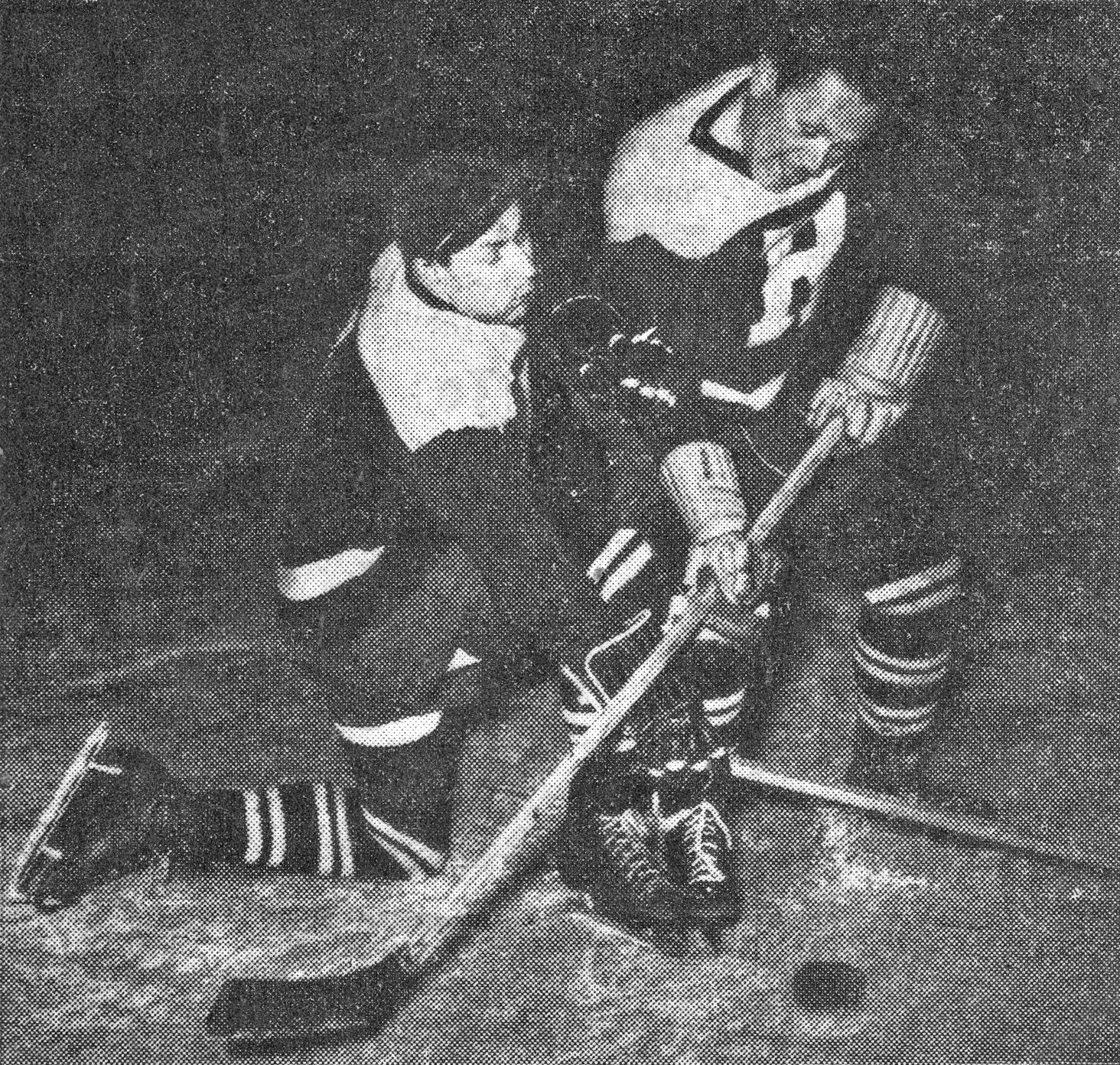
Sandy Miklos (left) and former Hungarian teammate, Tommy Endrei, at practice for the first match of the Internationals v. Australians series, August 1950, Melbourne. [31]
[1] Labour leaders feast capitalist underdog, Robert Gilmore, The Herald, Melbourne, Nov 19 1954. Skolnik said he was "a child refugee from the second wave of the notorious and bloody programs of Kashanov at the turn of last century." The reference is to the Kishinev pogrom of 1905. The "Ruhon" site of the 1st Australian Light Horse camp is not identified but they fought at Maghdaba and Rafa , the battles of Gaza, the advance to Jaffa, Beersheba, the west bank of the Jordan River, the raids on Amman and Es Salt.
[2] Victorian Boys win cup, Referee, Sydney, 10 Aug 1939.
[3] Wynn bought Café Denat in Bourke Street Melbourne in 1920, which later became Florentino's restaurant (Grossi Florentino).
[4] Seeks Goods For Middle East, Army News Darwin, 20 Sep 1945, p 2.
[5] Births Deaths and Marriages Victoria, Reg No 11367/1961. Death certificate of Jack Skolnik.
[6] Melbourne man can't aid in hunt for Red, The Argus, 2 Nov 1954, p 5.
[7] Births Deaths and Marriages Victoria, Reg No 19762/1954. Marriage certificate of Jack Skolnik and Rita Rockman.
[8] Clogball: Remembering the Dutch football clubs of Australia, Shout Farken, Adam Muyt, November 12 2015. Originally published in the July-August 2015 edition of the Dutch-Australian magazine, Holland Focus. Adam Muyt is the author of Maroon & Blue: Recollections and Tales of the Fitzroy Football Club.
[9] Wilhelmina was so prominent in eastern Melbourne soccer circles in the late 1950s and early 1960s that the club helped spawn a cluster of local district clubs too, each with significant Dutch backing, involvement and leadership. These sides included Hollandia, Fern Tree, Ringwood United and Mooroolbark. The latter club eventually played in the 1977 season of the National Soccer League, the forerunner of the A-League, meaning two sides (out of fourteen) had significant Dutch connections in that inaugural first season of the national competition (Brisbane Lions were the other).
[10] Meet the man who finances soccer tours, The Sun-Herald, sporting section, April 7 1957, p 57.
[11] Solnik Oval history, KaleidoScope newsletter, Mount Scopus College, Ed Vicki Davis, Melbourne, June 2015.
[12] On the Ice, Sporting Globe, Stan Gray, 21 October 1953, p 4.
[13] Ice hockey discord leads to breakaway, Sporting Globe, Stan Gray, 30 December 1953, p 5.
[14] Boom season for ice hockey, Sporting Globe, Stan Gray, 20 May 1950, p 15.
[15] Foul ice hockey, Sporting Globe, Stan Gray, 12 Sep 1951, p 15.
[16] Higher Calibre of play, Herald, Melbourne, 20 May 1950, p 26.
[17] Bombers from NSW for ice hockey here, 17 October 1953, p 25.
[18] Ice hockey premiership comes to Victoria, Herald, Melbourne, 24 September 1949, p 21.
[19] A Life to Live... Israel Kipen, Hybrid Publishers, Melbourne, 1989.
[20] H V Evatt and the establishment of Israel: the undercover Zionist, Daniel Mandel, University of Melbourne, Frank Cass Publishers, London, 2004.
[21] Sporting Globe 9 Jun 1954.
[22] Sporting Globe 21 Apr 1954/
[23] The Raiders are building a tremendous record, Sporting Globe, 29 Sep 1954.
[24] Jewish Business News, July 8th 2014.
[25] 5 of 7 of the wealthiest people in Australia are Jewish, JTA, The Times of Israel, 27 May 2018.
[26] Sporting Globe, Melbourne, 21 Apr 1954
[29] Sporting Globe 9 Jun 1954.
[30] In Black and White, The Herald, 17 Nov 1954, p 3.
[31] Former Hungarians clash on ice, cover of the The Herald, Melbourne, August 17 1950.
[32] The Argus, Melbourne, 3 February 1951.
[33] Hakoah defies Council, The Argus, Melbourne, 11 May 1955.
[34] Annual Report, Sid Hiort, Victorian Ice Hockey Association, Melbourne, 1950.
[35] Herschel Rockman's brother Norman was part of the chain store success. His son Irvin became Lord Mayor of Melbourne in August 1977. The former Jewish Athlete of the Year was a successful hotelier and tourism authority figure who owned the Rockman Regency hotel in Melbourne.

